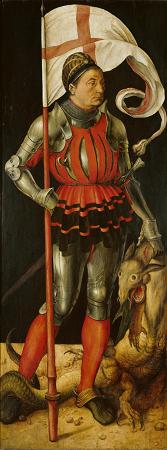Saint George. Killed dragon, decapitated. Saint George was a soldier of Cappadocian Greek origins, member of the Praetorian Guard for Roman emperor Diocletian, who was sentenced to death for refusing to recant his Christian faith. He became one of the most venerated saints and megalo-martyrs in Christianity, and he has been especially venerated as a military saint since the Crusades. In hagiography, as one of the Fourteen Holy Helpers and one of the most prominent military saints, he is immortalised in the legend of Saint George and the Dragon. His memorial, Saint George's Day, is traditionally celebrated on 23 April. England, Ethiopia, Georgia, Catalonia, and several other nation states, cities, universities, professions and organisations all claim Saint George as their patron. Very little is known about St George's life, but it is thought he was a Roman officer of Greek descent from Cappadocia who was martyred in one of the pre-Constantinian persecutions. Beyond this, early sources give conflicting information. There are two main versions of the legend, a Greek and a Latin version, which can both be traced to the 5th or 6th century. The saint's veneration dates to the 5th century with some certainty, and possibly still to the 4th. The addition of the dragon legend dates to the 11th century. The earliest text which preserves fragments of George's narrative is in a Greek hagiography which is identified by Hippolyte Delehaye of the scholarly Bollandists to be a palimpsest of the 5th century. An earlier work by Eusebius, Church history, written in the 4th century, contributed to the legend but did not name George or provide significant detail.The work of the Bollandists Daniel Papebroch, Jean Bolland, and Godfrey Henschen in the 17th century was one of the first pieces of scholarly research to establish the saint's historicity via their publications in Bibliotheca Hagiographica Graeca. Pope Gelasius I stated that George was among those saints whose names are justly reverenced among men, but whose actions are known only to God. The most complete version of the fifth century Greek text survives in a translation into Syriac from about 600. From text fragments preserved in the British Library a translation into English was published in 1925. In the Greek tradition, George was born to Greek Christian parents, in Cappadocia.His father died for the faith when George was fourteen, and his mother returned with George to her homeland of Syria Palaestina.A few years later, George's mother died. George travelled to the capital Nicomedia and joined the Roman army. George was persecuted by one Dadianus. In later versions of the Greek legend, this name is rationalized to Diocletian, and George's martyrdom is placed in the Diocletian persecution of AD 303. The setting in Nicomedia is also secondary, and inconsistent with the earliest cultus of the saint being located in Diospolis. George was executed by decapitation before Nicomedia's city wall, on 23 April 303. A witness of his suffering convinced Empress Alexandra of Rome to become a Christian as well, so she joined George in martyrdom. His body was returned to Lydda for burial, where Christians soon came to honour him as a martyr. The Latin Acta Sancti Georgii follows the general course of the Greek legend, but Diocletian here becomes Dacian, Emperor of the Persians. George lived and died in Melitene in Cappadocia.His martyrdom was greatly extended to more than twenty separate tortures over the course of seven years.Over the course of his martyrdom, 40,900 pagans were converted to Christianity, including the empress Alexandra. When George finally died, the wicked Dacian was carried away in a whirlwind of fire.In later Latin versions, the persecutor is the Roman emperor Decius, or a Roman judge named Dacian serving under Diocletian. There is little information on the early life of Saint George. Herbert Thurston in The Catholic Encyclopedia states that based upon an ancient cultus, narratives of the early pilgrims, and the early dedications of churches to Saint George, going back to the fourth century, there seems, therefore, no ground for doubting the historical existence of St. George, although no faith can be placed in either the details of his history or his alleged exploits. According to Donald Attwater, No historical particulars of his life have survived. The widespread veneration for St George as a soldier saint from early times had its centre in Palestine at Diospolis, now Lydda. St George was apparently martyred there, at the end of the third or the beginning of the fourth century; that is all that can be reasonably surmised about him.
more...













